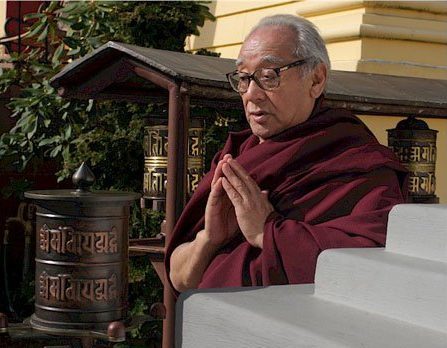Preserving the Sakya Tibetan Buddhist Heritage for future generations
From the Archives – Dharma Lecture 2006

Brief Dharma Lecture by H.H. Jigdal Dagchen Dorje Chang
January 15, 2006
Refuge and Chenrezi
Translator: Dr. Jeffrey Schoening
Transcribed by Ogyen Choezom
So, Adrienne has explained already the practice we do here at the Monastery briefly. And Rinpoche will give more explanation now about what is being done.
So, we come to the Monastery to do wholesome practices. But also, to understand what our unwholesome practice is, what’s non virtuous. And our focus needs to be on our motivation. This is really the basis––what is our motivation?
Some of you have been coming here [the Monastery] for a long time. And some of you are new here. Those of you who have been coming here for a long time are familiar with the practices we do here. For those of you who are new here at the Monastery, you are not familiar with these practices, and they can be difficult to understand. So, Rinpoche is going to briefly go over the practices to help you with understanding them.
The basis of all phenomena is our mind. So, when we do the practice, it’s very important that we have an understanding of our minds. So, this is very important. The mind is where the practice is done.
So, to begin, we take refuge here at the Monastery. With the objects of refuge. We are the ones who take refuge. There is both of these; there are the objects in which we take refuge, and the individuals who are taking refuge.
So, the three objects of refuge are the Buddha, the Dharma, and the Sangha. The Dharma that we practice here is both of the sutra and the tantra classes. In the sutra class, there are three objects of refuge, as mentioned… the Buddha, the Dharma, and the Sangha. But in the tantra tradition, there is a fourth object of refuge.
So, the practice we just did or the recitation we just did, the praises of the Buddha, this is in the sutra tradition. In the tantra tradition, our practice is where we meditate on a meditational deity, a Yidam. So, in that tradition is the Chenrezi practice. Chenrezi is a meditational deity.
When we do the practice, it is important to understand the meaning of what we’re doing. Therefore, we use our consciousness for this, our minds. In that connection, we do a practice that involves the Three Doors of Liberation. The Three Doors of Liberation are done in the context of an object or basis, a cause, and a result.
At the bottom of page 16, there’s the mantra, TAYATHA OM MUNI MUNI MAHA MUNI SHAKYA MUNIYE SOHA. And this is a mantra that combines both of the sutra and the tantra. Or the significance of sutra and tantra. And this is a mantra we will repeat 11 times.
Link to audio recording: https://www.sakya.org/2009/12/chenrezi-teaching-1-15-2006/